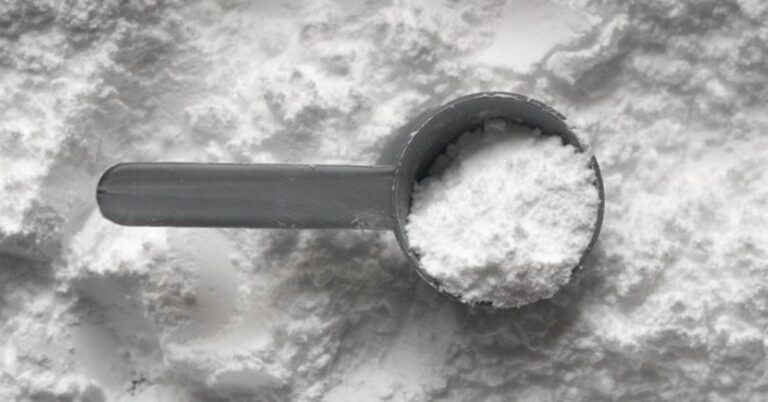If you’re just starting to use creatine supplements, you probably want to know just how long does it take for creatine to work? Creatine is one of the most studied supplements and is hugely popular amongst athletes and amateurs looking to boost strength and muscle mass. But what’s the timeline for seeing results?
The answer depends on several factors. In this article, I’ll guide you through everything you need to know about how quickly creatine takes effect and how to maximize its benefits.
It takes around 5-7 days to see the benefits of creatine kick in based on performing a loading phase, or within 3-4 weeks without loading. To maintain higher creatine levels long-term, it is recommended to take 2-5 grams daily after loading to maintain muscle saturation. It takes at least a month to fully see the effects of creatine supplementation.
What Exactly Is Creatine?
Let’s start with the basics—what is creatine?
Creatine is produced naturally in the human body to supply energy to cells, particularly muscle cells. It’s synthesized in the liver, pancreas and kidneys from amino acids.
Our bodies naturally make around 1 to 2 grams of creatine per day, with additional creatine supplies coming from food sources like meat and fish. It’s then stored as phosphocreatine primarily in your muscles and brain.
When you need quick energy for high-intensity activities like sprinting or weight lifting, your body breaks down phosphocreatine to form adenosine triphosphate (ATP). This provides those short, intense bursts of energy.
Supplementing with creatine simply increases the available stores of phosphocreatine in your muscles. More phosphocreatine means the potential for more ATP energy production.
Why Do People Take Creatine?
If your body already makes creatine, why supplement?
The reasons why athletes, weightlifters, and others seek out creatine include:
- Build strength and power for high-intensity activities
- Increase muscle mass and size when combined with training
- Improve cognitive performance and mitochondrial function
- Enhance recovery between workouts
- Boost results when trying to add muscle mass
Research has confirmed these benefits in multiple studies. Creatine is one of the most effective supplements for improving performance during exercise involving quick bursts of power and strength.
Creatine Explained! – What Is It & What Does Creatine Do?
What Are The Benefits of Creatine Supplements?
Increase Strength and Power
Creatine has been shown in numerous studies to significantly boost strength and power output, particularly during short bouts of high-intensity exercise.
For example, one study found power output increases of approximately 17% during bench press exercises and 20% during half-squat exercises.
Boost Muscle Mass
Creatine supplements are also effective for increasing lean body mass and overall muscle growth, especially when combined with exercise.
A 2013 meta-analysis found creatine use increased average muscle mass gains from weight training 1.32kg compared to placebo groups.
Improve Cognitive Performance
Surprised that a gym supplement can boost your brain? It’s true – studies show creatine may have cognitive benefits, including improved working memory and intelligence.
There’s also research indicating potential neuroprotective effects, such as this study that shows creatine supplements reduce mental fatigue.
The cognitive benefits likely stem from increased phosphocreatine stores in the brain.
Enhance Recovery
By increasing phosphocreatine stores and aiding ATP energy production, creatine appears to reduce muscle damage and soreness following strenuous exercise.
This study found that creatine allows for an increased strength output when recovering from exercise-related muscle damage.
How Soon Does Creatine Start Working?
So we’ve covered the many benefits, but when do they kick in?
Creatine loading protocols, which involve taking a higher dose daily, can saturate your muscles within 5 to 7 days.
Without a loading phase, studies show it takes about 4 weeks to maximize creatine muscle stores and see effects.
However, many users report noticing at least some ergogenic effects within the first 1 to 2 weeks even without loading. The benefits accrue over time.
Once your muscular creatine levels are fully saturated, the effects can stay elevated with a continued lower daily dose.
Let’s look more closely at loading and saturation timelines.
Creatine Loading Phase
A common creatine loading phase looks like this:
- 20 grams per day for 5 to 7 days
- Split into 4 doses of 5 grams
- Followed by lower maintenance dose of 3 to 5 grams
This rapid loading quickly boosts the creatine content in your muscles. Studies confirm that just 5 to 7 days of high-dose supplementation can increase creatine muscle stores by over 20%.
Without loading, it takes about 4 weeks to achieve these muscle creatine levels.
So if you’re looking for effects ASAP, a proper loading protocol is highly effective. Just be aware that rapid loading causes more water weight gain, meaning you’ll need to increase your water intake.
Time to Saturation
In total, creatine muscle saturation happens in the following general timelines:
- With loading: 5 to 7 days
- Without loading: 3 to 4 weeks
The fastest way to maximize creatine’s ergogenic effects is to front-load for a week.
But what if you choose to forgo loading? Even then, studies indicate you can expect to see meaningful strength and performance benefits by weeks 3 to 4 as stores reach full capacity.
No matter how you dose it, give creatine at least a month before judging its effectiveness.
Maintaining Creatine Levels Over Time
Once your muscles are saturated with creatine, maintaining this level only requires about 2 to 5 grams per day.
This keeps muscle phosphocreatine levels elevated.
Unlike some other supplements, your body does not appear to develop a “tolerance” or adaptation over time that reduces creatine’s effects.
Research shows consistent benefits even with long-term use of several years. Plus, studies demonstrate no attenuation in performance when users cycle on and off creatine.
However, you may notice some slight decrease in strength and muscle mass within 4 weeks of fully stopping supplementation as your stores decline.
All told, to maximize ongoing benefits, continuous daily supplementation with low doses is ideal once saturated.
Why Some People See Limited Results
It’s true that a small percentage of users see less pronounced results from creatine supplementation.
Studies estimate non-response rates are up to 30%. Possible reasons include:
- Genetic factors: Some gene variations impact creatine uptake and usage.
- Diet: Those who eat high meat diets may already have saturated stores.
- Muscle fiber types: Creatine works best for powering type II fast-twitch fibers.
- Dose: Non-responders may need higher loading and maintenance doses.
So while most people see significant gains, creatine is not 100% effective for everyone.
Try a proper loading protocol and give it several weeks to judge whether you’re a responder. Consider slightly higher doses if you’re seeing limited gains.
Is Creatine Safe?
When taken as recommended, creatine is considered very safe and well-tolerated.
Extensive studies lasting years have uncovered no serious side effects in healthy individuals.
The primary side effect is water weight gain of about 2 to 6 pounds during loading, due to muscles holding more water. This subsides over time.
There’s no evidence creatine harms your liver or kidneys at suggested dosages.
“In summary, experimental and controlled research indicates that creatine supplementation, when ingested at recommended dosages, does not result in kidney damage and/or renal dysfunction in healthy individuals.
https://www.ncbi.nlm.nih.gov/pmc/articles/PMC7871530/
“
Research indicates creatine supplementation can provide benefits like increased energy, power, strength, muscle mass, and post-workout recovery in athletes. However, for under 18’s, more research is needed on the safety of taking creatine supplements. More information can be found here.
The Bottom Line
Creatine offers impressive benefits for power, strength, muscle gains, and mental performance. But how long does it take to start working?
Here’s a quick summary:
- With a proper loading protocol, expect results in 5 to 7 days as muscles become saturated.
- Without loading, allow about 4 weeks for creatine stores to maximize.
- Maintain higher levels long-term with 2 to 5 grams daily post-loading.
- Stay patient through an initial “loading” phase of at least 1 month to see if you respond well.
- Creatine is safe for long-term use at recommended dosages.
If you’re looking for a way to take your training to the next level, creatine can deliver. Stick with it for a month to experience the strength and muscle-building effects firsthand.
For more information on creatine and other supplements, see this article







